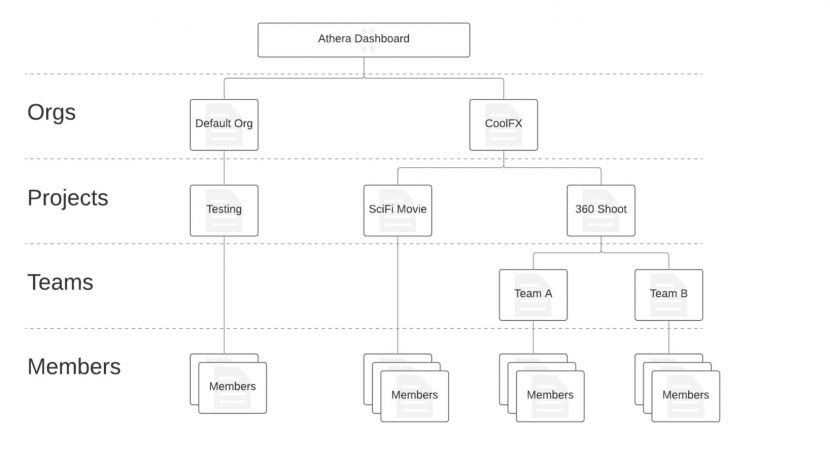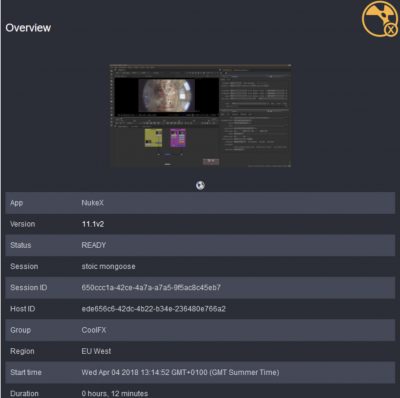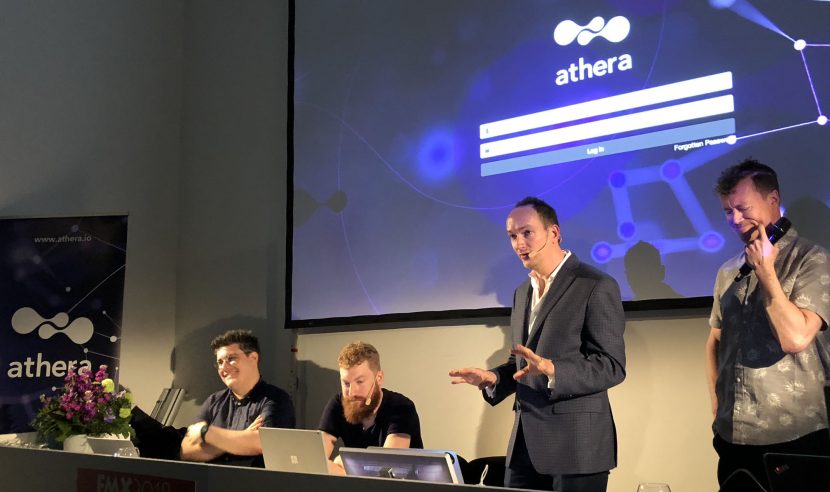Last week at FMX, the Foundry officially launched their cloud offering hub. Athera lets you run applications, from the Foundry, and others such as Houdini, on a virtualized PC on the cloud. This has been in development for three years at the company.
In many respects Athera is a reflection of a major move to virtualise the pipeline. A few major companies have private clouds already where the artist has a zero client (dumb) terminal / web machine that just acts as a satellite for the companies virtual PCs. For these existing companies, this means their artists in LA or Vancouver could be using shared machine ressources, but neither cares or perhaps even knows where that hardware actual is location.
The Athera project is not initially aimed at these big vfx houses, it is aimed more at the indie freelancer. While virtualized pipelines do exist for the majors, they are complex to set up and require a lot more infrastructure than most people fully appreciate. In addition users would need to worrying about virtual networks and other implementation issues. Athera handles all of this.
For the indie freelancer, the cloud option also raises the issue of security. A private cloud is a more controlled environment that a general cloud solution. When working with clients ‘all on the Cloud’ is not always a reassuring selling point.
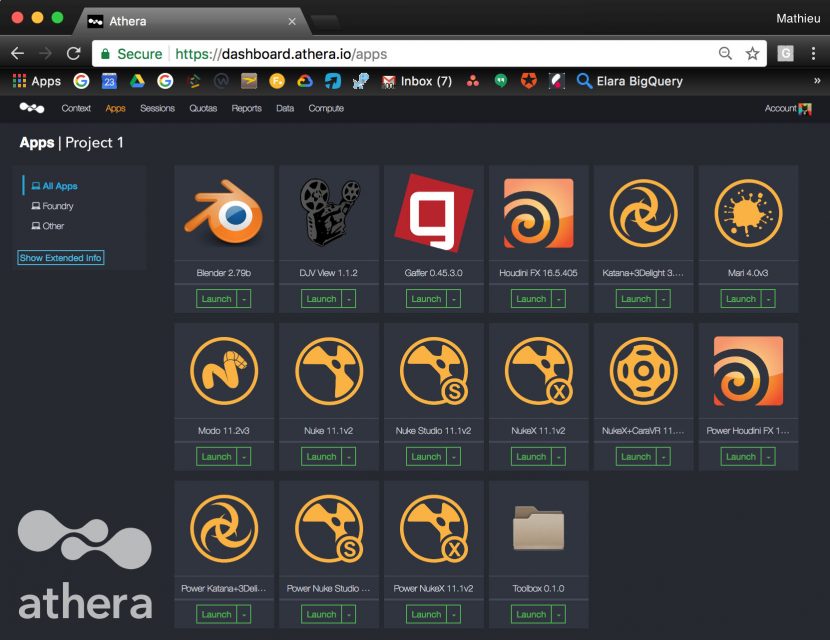
The Foundry has addressed the issue of security by partnering with Google Cloud. The system is robust, audited and provides to an individual the power and security previously hard to prove. Google Cloud also provides the best shot at low latency from their extensive (one might say monumental) tech infrastructure worldwide. Latency is key when the files and machines are not co-located with the artist.
The great thing about Athera is that you’re only charged when you’re actually using it. There are no recurring subscription costs, and you can easily change what software you are licensing. This means you can scale your usage down to zero and pay nothing during lulls, and ramp back up instantly for your next big project on a month by month basis.
Without the tech IT support of a major facility, most freelance VFX specialists become their own IT experts out of necessity. This is a costly factor in daily life, not just for the cost of staying up to date with the tech, but also the opportunity cost of stopping work on your great fluid sim and having to get out a screwdriver to rebuild your PC as something has broken, crashed, or given up the ghost. A cloud solution that provides a solution to this lost production time. If the cloud PC breaks, it is Google’s problem, not yours.
How it works
The system can either by Web base or run via the Orbit client downloaded app. In both cases the files, the caches and all the crunch power is in based in a central hub. As the owner, you will have an account and completely airlocked separate projects. This means that no client’s work can be seen or lost to another project. The whole system comes with software and compute power but not storage.
While one can connect any online storage to Athera, such as Dropbox or a normal Google drive, many of these services are not designed for fast access. GCS is the best option for performance. It is not mandatory, but for major jobs beyond a free trial test, we would recommend it. That being said, for roto work or lower complexity comps, most beta users have been happily using Dropbox and anyone doing evaluation could easily use their existing cloud account.
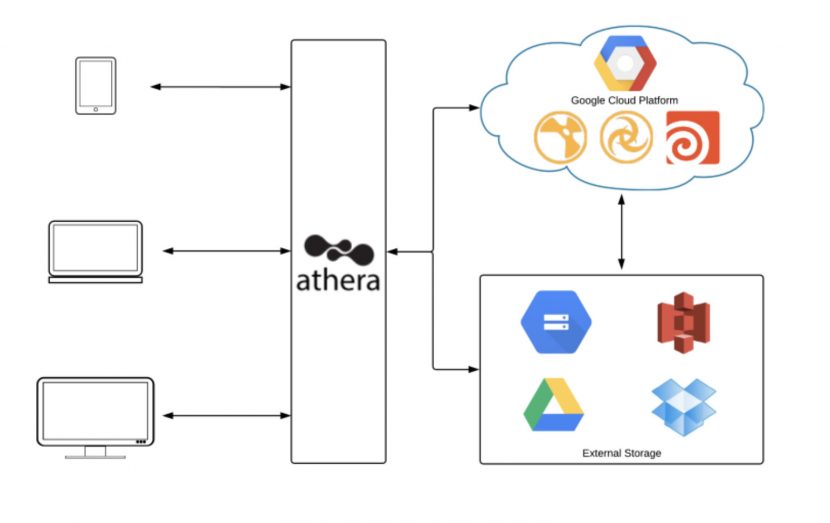
The actual computer on your desk does very little with Athera. It can be almost anything.
While your own computer can be an old crappy Mac Airbook, this hides the fact that many people will still want a high quality monitor and if you want to emulate your current multi-screen setup then the downloadable App provides the best option. That being said, Simon Robinson, Chief Scientist from the Foundry admitted that he sets up tests on the train to work, then closes his Macbook, reads a book while the whole Nuke test is done and rendered, ready for when he re-opens his laptop in the office.
At the launch, Hugo Guerra of Fire Without Smoke, who has been on the Beta program, showed how he has been buying cheaper and cheaper $57 computers, – just to prove the point that a near throw away old clunker still acts like a state of the art NUKE box with Athera. It just needs to be able to run a web browser.
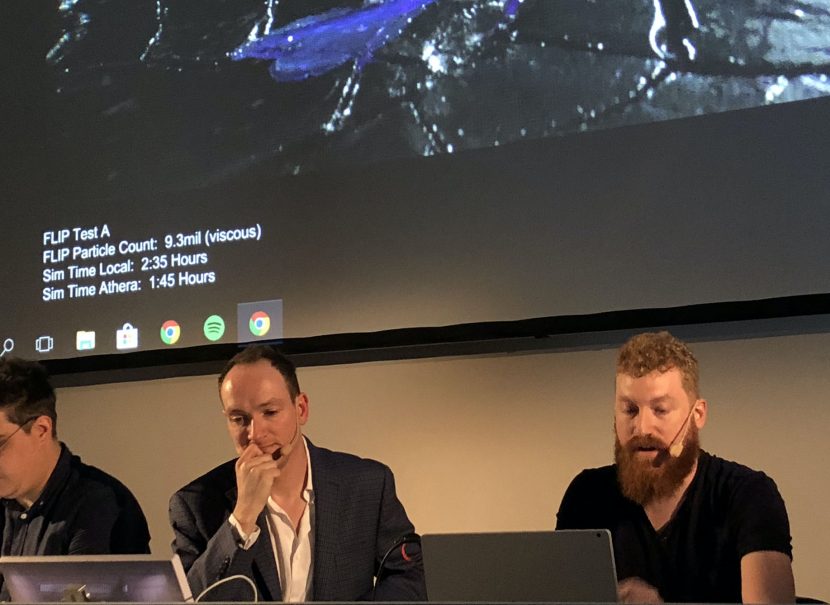
By contrast, CG Supervisor Patton Tunstall from ATK PLN presented a different view. He did not want to discuss the desire to “sit on a beach and work”. He is focused on having an incredibly fast, state of the art machine, that can do complex fluid sims in Houdini without compromise. Tunstall showed very complex fluid sims he had done on the system, with variable viscosity, all without a problem. Tunstall’s setup uses the Orbit downloaded App, which is also the only way to work with a tablet, as the web browser does not properly support Wacom use.
Above the PattonTunstall’s “Bloody Golden Stairs” Test 2K render Output.
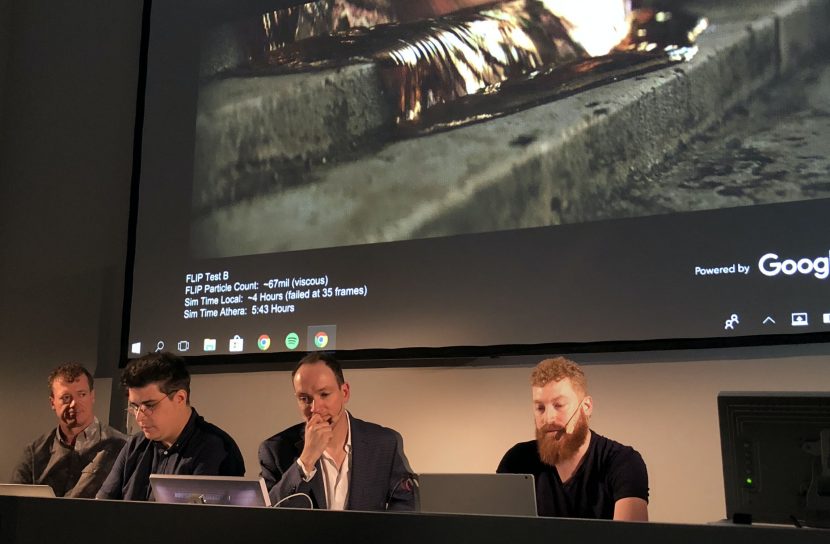
Setting up
As a facility you pick the amount of computer power you want on a monthly basis. Some artist may desire shorter term rentals but for now the production unit is a month. Once you have signed up with a credit card you can add multiple users and define limits on their work units. This avoids the problem of an artist getting carried away and blowing your credit card/ production budget before you have a chance to notice.
From the Athera Dashboard you set up Orgs. An Org represents a company or collective of customers that can contain one or more Projects. Projects reside within Orgs. Projects can be used to break work down into smaller, discrete chunks within an Org.
Orgs are the top level groups in Athera and are listed first in the current Context.
The Context also provides access to services such as quotas, usage, and storage. “Contexts are important, because they wrap around everything that is associated with your production or your shot, …your storage, your roles and projects – and when I switch context all those things switch with me” explains Mathieu Mazerolle, the Foundry’s senior product manager for the project.
Entitlements and Quotas
Entitlements come in one of two types, either a ‘credit’ for rendering that you run down, or the monthly system entitlements which is the number of application specific machines you have booked.
Entitlements control which Apps your Members have permission to use within an Org. You can limit someone to having only say 40 hours a week of Nuke as a quota.
Quotas control hourly usage for Interactive sessions and how many Parts of a Compute session can use to complete the required processing. i.e. how much render farm budget they can burn through. One of the central advantages of the project is the flexible and easily scalable render farm.
Why do it? Does the maths stack up?
The key points come down to a secure, scalable system that provides the latest hardware, and powerful project or facility management controls, especially for distributed teams.
There is a complex cost benefit equation. The ‘rented’ virtual machines cost money, but save money by avoiding capital costs. Much VFX equipment is leased to avoid spikes in cash flow demands, (if interest rates rise, this could be a significant issue). Leasing equipment assumes a stable workload or production demand. Athera is inherently something you can adjust monthly to load balance jobs with machine costs.
But this only captures part of the economics. The artists time is more valuable and harder to scale than machines. With a virtualized pipeline an artist could start a complex shot, and reach a point that they need to render or do simulations that would consume most of their CPU/GPU. With Athera they could keep working with a duplicate PC without moving from their desks. In theory, one artist has no limit on how many actual high end machines they could run at once, since each is a separate fully functioning PC, just on a shared virtual network.
Another important consideration is the notion of being fully on the cloud vs just cloud rendering. If all one’s files are on the virtual PC, there is no expensive upload and download when using a render farm. The files are ‘local’ to the cloud and locally written. As an artist one just views those frames back at your desk, but the OpenEXRs are still on the cloud. (More on that below). It is actually more useful to think of Athera as a virtual pipeline than a cloud solution. Certainly, no client will demand you have a cloud infrastructure, but they may appreciate you have one of the best teams, using artists distributed around the world, all working together quickly and effectively.
In addition to savings on maintenance and IT support, this way of working does allow an artist to travel and work. A simple laptop computer with reasonable internet can provide the power of a massive dedicated system. From a client visit to onset, you can work effectively anywhere without having shipping 4 road cases of PC gear.
Pricing (per month)
Houdini FX is US$1276 a month (* Mantra is also a render option at $1 per hr)
Nuke is US$685
Nuke X is US$1,105
Nuke Studio is US$1,141
The higher spec PCs increase the price, so the Houdini moves from $1,276 up to $1,523 for the “POWER HOUDINI FX” option with twice the RAM, more cores and a second GPU. At the moment the configuration is tied to the application. In the future you will most likely be offered an option to rent the license separately from the hardware allowing for more dynamic arrangements.
Plus also Mari, Modo, Katana etc are all options – for full pricing see their site
- Interestingly, Blender is included but not free, something that some Blender users had issue with this week. The reason is that the Blender’s $244 a month pays for the Blender H/W. Any of these figures can not be just thought of a software licence.
Bandwidth Recommendations
The amount of bandwidth required for Athera to run smoothly depends on the size and resolution of the files you’re streaming from storage.
.• 0.5 Mbit/s – the minimum connection speed for broadband ( not recommended but it works)
• 1.5 Mbit/s – the recommended connection speed for broadband.
• 3.0 Mbit/s – the recommended connection speed for SD quality content.
• 5.0 Mbit/s – the recommended connection speed for HD quality content.
• 25 Mbit/s – the recommended connection speed for Ultra HD (4K) quality content.
The imagery is only 8 bit right now from Athera to the artist. To move to 10bit, the Foundry will be working with Teradici’s powerful hardware decode capabilities. The specialist PCoIP company’s system, once added, will allow for adjustable bandwidth. “It applies different compression algorithms to different parts of the screen space, for example it treats fonts differently from footage, it has adaptive compression and that is one of the reasons it is so great”, comments Mazerolle. As an alternative, until Teradici is available, he goes on to suggest that “the Foundry offers TurboVNC, which is now a standard desktop thing that is super easy to set up and it provides something that looks pretty good. But we know the real pros will want Teradici”. TurboVNC is a derivative of VNC (Virtual Network Computing) that is tuned to provide peak performance for 3D and video workloads.
Latency
Latency can be a significant factor affecting your experience with interactive application sessions. The application region used is auto-detected, but you can override the selection if you choose.
Below are some rough guidelines to latency.
• < 40 ms – optimum working condition.
• < 80 ms – some lag may occur, but Athera should work as normal.
• > 80 ms – anything greater than 80 ms can cause Athera to become sluggish.
When discussing streaming footage to the remote desktop of the user, Mathieu Mazerolle commented “I always point to Netflix. People stream 4K on Netflix, and we demand less than Netflix as not all the screen is normally moving (menus etc)”.
Advantages
Security has really been thought through, one can even limit internet access with whitelisted IP addresses from inside Athera. It is designed to be secure from the ground-up and has undergone a comprehensive independent cyber-security audit, Independent Security Evaluators (ISE).
The other security feature that comes out of the fundamental structure of the cloud is access to original source. We spoke to one beta tester, who has been using it since the first Beta, and they pointed out that with ad doc remote teams, there is always some risk in distributing source files to team members. With Athera, while any approved team members can see the material, they don’t ever actually have local copies of any of the master source files. All the source files only exist on the cloud machine network, with only down res versions being viewed by the artist at any one time.
A huge advantage of Athera is that is easy to have the latest Hardware. The system has a limited set of options for the current configurations, but more will be added right now there are two primary configurations:
Standard Nuke/Houdini machine which has 8 cores, 30 Gig and 1 GPU in the virtual machine.
‘Super Sized’ Nuke/Houdini machine 16 cores, 120 gig and 2 GPUs.
- The GPUs are Nvidia TESLA GPU units.
There is also excellent tools to monitor your work.
Roll out:
The product is available via the UK and West Coast USA server hubs and more are being rolled out in partnership with Google. “We are probably a couple of weeks away from US East coast, then probably Sydney, then another one in Europe, then central US, that is probably the schedule, it is not hard, nor that expensive, we just want to make sure that they can handle the load and scale” commented Mazerolle. As for the product itself it is planned to have two week updates initially as the product moves from beta. It is a standard web services deployment model and not the standard Nuke product schedule model.
Disadvantages
Plugins are an issue as is tools for replay/review versioning. As it stands not all the plugins a Nuke artist might want are possible. There have been some added to the base build, for example Psyop: Cryptomatte Nuke plugin is included, but generally this is not the case. For example, if you wanted to use the NUKE plugin bokeh from peregrinelabs.com it is not possible on Athera. The Foundry creates a software defined network around each session, so there is not really anyway for that session to speak to anything such as a Licence server. In the future the company will be offering third party plugins. Any Nuke Gizmos from your own set up (not requiring licensing) can be used easily. There is also Python Scripting possible.
Future extensions will also allow users to sync not just to ‘licenses on premise’ but sync ‘footage to on premise’ – allowing an easy mix of some artists working on the cloud and some locally at your facility.
The Foundry does not yet have a long list of partners. The biggest and most significant is Side Effects with Houdini. There was some other major 3D apps offered at various stages in beta but these are not available at the time of the launch. It is expected many will join soon, especially companies like Chaos Group with V-Ray, but there is still a major question mark over Autodesk products such as Maya.
Athera is not a fully implemented PC on the cloud. There are companies offering full PCs over IP (PCoIP) but this is not what is being offered by the Foundry. There is no standard windows desktop or normal PC windows environment. What is offered is a curated pipeline experience.
The keyboard mapping is also Linux not Mac so when running a virtual PC, on a Mac you need to use the standard PC keyboard layout.
It is not possible right now to copy and paste between session. But Jon Wadelton, Foundry CTO is quick to point out that many of these things are being addressed, but “the system has a solid and secure, file browser, and terminal – which is the fundamentals to manipulate files, and with more coming”.
Archiving is always going to be an issue on the cloud, while it is not being sold or packaged by the Foundry. Mazerolle comments, “it is pretty hard to beat Coldline Storage with the cloud provider, unless you go to tape”. Referring to Google’s Cloud Storage Coldline which is a low-cost, highly durable storage service for data archiving, online backup, and disaster recovery. Data is normally available within milliseconds, not hours or days. It is ideal for storage of data that one plans to access at most once a year, due to its slightly lower availability. It is however a 90-day minimum storage duration, and with costs for data access, making it a higher per-operation cost that the standard professional GCS. Users could also use AWS: Glacier in combination with standard S3 AWS storage.
Wadelton commented that on the issue of storage generally, the Foundry was going to package the whole end to end system, but then realised that it should separate off production and archive storage. “When we spoke to clients they were naturally very precious about their storage, and if someone declines a credit card, we don’t want to be holding onto your data wondering what to do,.. so we went for the approach of you bringing your own storage solution and plugging it in”. But Wadelton does think that over time this may change and the Foundry may become more involved as the service evolves and grows.
Data input can be an issue. If the files are not on the cloud yet then uploading them over broadband can take hours depending on the size of the project. ” I forgot about that” commented Guerra, “it is a blank machine that doesn’t have anything on it, I have to load the files, so for example if you have to load a 100 gigs from dropbox to this system, then I am only getting 50 Megs/ sec, so that can take 6 or 7 hours – which is a limitation I had not thought about”. Note: Once there, this does not need to be repeated between sessions.
The actual cloud machines have very little local hard drives so large Caches may be an issue. For example Deep Files will need to use the Athera ‘Atlas storage’ system to cache. A single shot could be a Terabyte of deep data for a 4K shot, which may overdrive via cache system, but this is unclear at this point. It did not seem to be an issue for the Houdini Sims work. In fact in one example that was shown by Patton Tunstall at the launch of a variable viscosity sim (FLIP test B) after 4 hours the sim failed locally in the office, (35 frames in). The Athera Cloud version completed the sim in 5.43 hours.
The launch event at FMX
At FMX there was an impressive launch event. Google’s support was very much in evidence, and Google is clearly key for both security and speed. The team ran the software live from a laptop via a web browser and the Orbit App.
CG Supervisor Patton Tunstall showed the most impressive footage of the night (see below). He seemed to have done the most robust testing of Athera, doing complex sims with the tool, (but rendered locally).
But as impressive as Tunstall was, for sheer entertainment value along with hard core NUKE skills, – Hugo Guerra stole the show.
Hugo Guerra’s animated talk was a highlight of the event, as he recounted his move from facility artist to roaming freelancer to his testing of Athera. (If you ever get a chance to hear Hugo speak: do ). His main points, other than proving the product could run on anything (including his phone), was that the product suited the evolving nomadic freelancer model of collaborative workflows, often distributed around the world.
He separately spoke to fxguide away from the event. “I think it’s great, it is not perfect, it lags a little in some places, and I don’t feel I want to run a whole production yet, with advanced shots”. Guerra is keen to have the Teradici option. “But I think it is all in the right direction. I think it will take a few months to get it really perfect. So as much as I love what they are doing, I do think there is more to go. From a positive standpoint it has been really stable, and it has improved so much in the last month, it does not crash so much, the RAM allocations have been increased, all of this makes a real difference”. Guerra points out that The Mill in the UK uses Teradici to share files between offices and it works extremely well. He had previously been a 2D supervisor at the Mill before founding his own company Fire Without Smoke.
Guerra is also very keen to see the Autodesk products on the service, given his company’s clients and workflows. (They were on Athera on an earlier alpha/beta). His company is very distributed internationally and he agrees with the Foundry that the product will appeal to indie or smaller companies first. “Big companies have such an investment already and they have a lot of their own systems”.
He is also keen to have more tools that can use the high end GPU power in the Hardware configuration. For example, there is currently no Octane for Nuke, even with the Nvidia Tesla GPU cards, which would naturally be a good fit for the GPU power of Octane.
For Guerra, he is comparing his own highly developed eco-system of software and hardware, to the Athera offering. While the compute and NUKE power are available to him, his company has it’s own custom project management and job scheduling software which can not currently be accommodated inside the Athera structure. “I don’t use standard NUKE, I have a lot of my own things, such as automatic importers and exporters. For example, if I have a Maya artist working in Sweden who publishes a camera through our system, then I get a pop up in NUKE to say a new camera is available. I have all of that stuff automated… including copy pasting between users, and a bunch of tools”, which are all things he would like to see working seamlessly within Athera.
While he points to these real world short term limits, he is still very optimistic about the future of this style of work, and how he can use it inside his company.
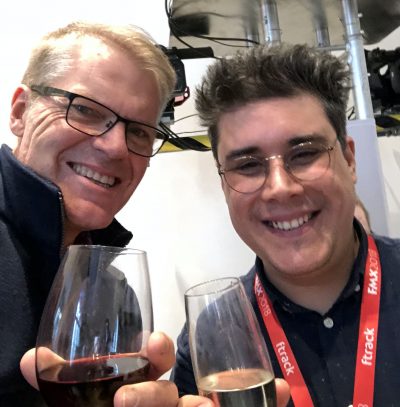
Bottom line:
Some people have suggested that this could be as significant for VFX as the introduction of digital cinema camera. It certainly feels like there is a huge industry move to PCoIP and virtualized workflows. For Athera to capture this and capitalize on it, it needs to:
- Add more applications
- Extend plugin and licensing
- Allow more flexibility with scripting
- Allow time for teams to experiment and then mirgrate
If this happens, then after some resistance, this could indeed become the defacto model for many teams, especially in this age of distributed global artists. The Foundry are to be congratulated for pushing forward technically, especially with their stated aim of helping small to medium teams.

